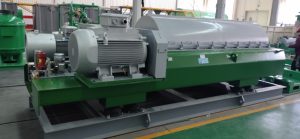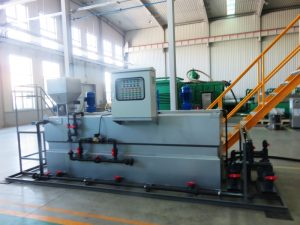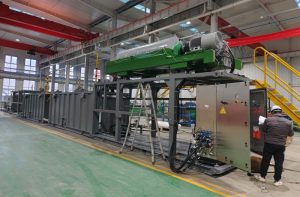The sale of two sets of decanter centrifuges to South American clients marks a significant milestone in the global expansion of our company’s innovative technology. These centrifuges, including the GNLW654 model, are designed to address the unique challenges of sludge dewatering in the South American region. In this article, we will delve into the original mechanical principles and price advantages of these decanter centrifuges, shedding light on their superior performance and cost-effectiveness.
The GNLW654 decanter centrifuge is a cutting-edge piece of equipment that embodies the latest advancements in centrifugal separation technology. Its unique features and original mechanical principles make it an indispensable tool for various industrial applications, particularly in the area of sludge dewatering. This section will delve into the innovative design and high-performance capabilities of the GNLW654 decanter centrifuge, showcasing its superior functionality and efficiency.
One of the key features of the GNLW654 decanter centrifuge is its robust and durable construction. The centrifuge is built with high-quality materials and precision engineering, ensuring its reliability and longevity in demanding operational environments. The use of stainless steel and other corrosion-resistant alloys enhances the centrifuge’s resistance to harsh chemicals and abrasive materials, making it suitable for a wide range of applications in the wastewater treatment, oil and gas, and mining industries.

In addition to its sturdy construction, the GNLW654 decanter centrifuge is equipped with advanced control systems that optimize its performance and efficiency. The centrifuge’s variable frequency drive (VFD) allows for precise control of the bowl and conveyor speeds, enabling operators to fine-tune the separation process according to specific sludge characteristics. This level of flexibility is crucial in achieving optimal dewatering results and maximizing the recovery of valuable solids from the slurry.
Furthermore, the GNLW654 decanter centrifuge incorporates a streamlined hydraulic system that minimizes energy consumption and reduces maintenance requirements. The use of hydraulic technology enables smooth and continuous operation, eliminating the need for frequent shutdowns and minimizing downtime. This not only enhances the centrifuge’s overall productivity but also contributes to significant cost savings for operators.
The mechanical principles behind the GNLW654 decanter centrifuge are rooted in the concept of differential speed and gravitational force. As the slurry enters the centrifuge, it is subjected to high centrifugal forces, causing the solids to settle against the bowl wall while the liquid phase is expelled through the liquid discharge ports. The rotating conveyor within the bowl then conveys the dewatered solids towards the conical end of the centrifuge, where they are discharged through the solids discharge ports. This continuous separation process relies on the precise control of bowl and conveyor speeds to achieve the desired dryness of the solids and the clarity of the liquid effluent.
In conclusion, the GNLW654 decanter centrifuge stands as a pinnacle of innovation and engineering excellence in the field of centrifugal separation technology. Its unique features, advanced control systems, robust construction, and efficient mechanical principles make it a highly sought-after solution for sludge dewatering and solids-liquid separation. By understanding the intricacies of its design and operation, users can fully harness the capabilities of the GNLW654 decanter centrifuge to meet their specific dewatering requirements with unparalleled performance and reliability.
2 Flocculation and chemical Dosing unit System
The 6000L flocculation and dosing system plays a crucial role in the sludge dewatering process by enhancing the efficiency of separation and dewatering. This system is designed to effectively treat the incoming slurry and facilitate the formation of large, fast-settling flocs. By optimizing the flocculation and dosing process, the system ensures the formation of well-defined flocs that can be easily separated from the liquid phase, leading to improved dewatering performance.

The mechanical principles behind the 6000L flocculation and dosing system are based on the principles of coagulation and flocculation. Coagulation involves the destabilization of colloidal particles to form microflocs, which are then brought together to form larger, more easily settleable flocs through the process of flocculation. The dosing system precisely controls the addition of coagulants and flocculants to the slurry, ensuring the optimal conditions for floc formation.
In practical applications, the 6000L flocculation and dosing system is capable of handling a wide range of slurry compositions and flow rates, making it suitable for diverse sludge dewatering requirements. The system is equipped with advanced mixing and dosing mechanisms to ensure thorough and uniform dispersion of the coagulants and flocculants throughout the slurry. This promotes the efficient formation of flocs and maximizes the separation efficiency of the decanter centrifuge.
Furthermore, the 6000L flocculation and dosing system is designed to be highly adaptable, allowing for precise adjustments to the dosing parameters based on the specific characteristics of the slurry being processed. This adaptability ensures that the system can effectively respond to variations in sludge composition and flow conditions, maintaining consistent dewatering performance across different operating scenarios.
In addition to its role in enhancing dewatering efficiency, the 6000L flocculation and dosing system also contributes to the overall cost-effectiveness of the sludge dewatering process. By promoting the formation of well-defined flocs and improving the separation efficiency of the decanter centrifuge, the system reduces the energy consumption and chemical usage required for dewatering operations. This results in significant cost savings over the long term, making the system a valuable investment for industrial and municipal wastewater treatment facilities.
Overall, the 6000L flocculation and dosing system represents a key component in the comprehensive sludge dewatering solution offered to South American clients. Its innovative design, precise dosing control, and adaptability make it an essential element in achieving optimal dewatering performance while minimizing operational costs.
3 Lifting Platform for Decanter Centrifuges
The lifting platform for decanter centrifuges is a crucial component that contributes to the operational convenience and safety of the entire system. Its design and functionality play a significant role in facilitating the installation, maintenance, and operation of the decanter centrifuges, ultimately enhancing the overall efficiency and effectiveness of the equipment.
The lifting platform is specifically designed to provide a stable and secure base for the decanter centrifuges. Its robust construction and precision engineering ensure that the centrifuges are securely positioned, minimizing the risk of instability or movement during operation. This is particularly important in the context of the GNLW654 decanter centrifuge, which is known for its high-speed rotation and powerful dewatering capabilities. The lifting platform effectively supports the centrifuge’s weight and provides a solid foundation for its operation, thereby enhancing safety and stability.
In addition to providing a stable base, the lifting platform also facilitates the installation and maintenance of the decanter centrifuges. Its design allows for easy access to the centrifuges, making it convenient for technicians to perform routine inspections, repairs, and adjustments. This accessibility is crucial in ensuring the optimal performance of the centrifuges over time. Furthermore, the lifting platform’s design minimizes the need for extensive disassembly or complex maneuvers, simplifying the installation and maintenance process and reducing potential downtime.
Moreover, the lifting platform contributes to the overall ergonomics of the system, enhancing the convenience and safety of operation. By providing a raised platform for the decanter centrifuges, it allows operators and technicians to access the equipment at a comfortable height, reducing the risk of strain or injury during routine tasks. This ergonomic design consideration aligns with the emphasis on safety and efficiency in the design of the entire decanter centrifuge system, ensuring that operational tasks can be performed with ease and minimal risk to personnel.

Furthermore, the lifting platform’s design is tailored to the specific requirements of the decanter centrifuges, ensuring compatibility and seamless integration with the equipment. Its dimensions and structural features are carefully engineered to accommodate the size, weight, and configuration of the centrifuges, maximizing the effectiveness of the support provided. This tailored design approach reflects a commitment to optimizing the functionality and performance of the decanter centrifuge system as a whole, highlighting the attention to detail and precision engineering that characterizes the equipment.
In conclusion, the original mechanical principles and price advantages of the two sets of decanter centrifuges offer valuable insights into the innovative technology and cost-effectiveness of our products. By understanding the unique features of the GNLW654 decanter centrifuge, the mechanical principles of the flocculation and dosing system, the lifting platform, the sludge tank, and the supply screw pump, South American clients can make informed decisions that align with their specific sludge dewatering requirements. This article serves as a comprehensive resource for industry professionals and stakeholders seeking advanced solutions for sludge dewatering.